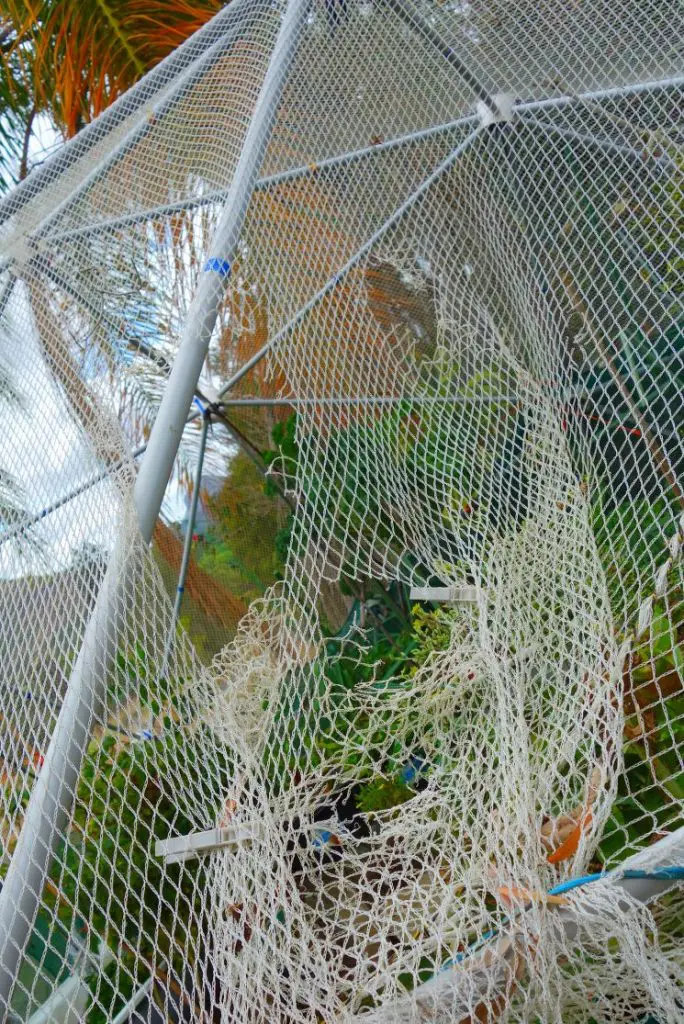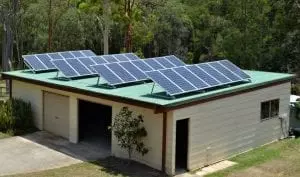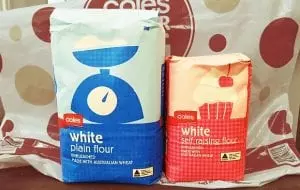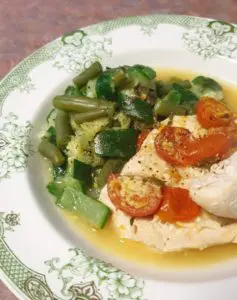This is the fourth part in a series of articles on my self-built geodesic dome greenhouse. If you need to catch up, here is part 3.
It’s All About the Possums! As if my problems with light and powdery mildew weren’t enough, I now had pest damage to contend with. Will it ever end?!
The summer vegetables were nearing their end. I’d left a few for seed saving, but most had been pulled out. The herbs were trundling along, and beginning to thrive as the temperature had generally cooled off.
The winter seedlings were thriving & I was expecting a bumper crop. Purple and white cauliflowers, two varieties of broccoli, numerous sugarloaf cabbages, various tomatoes, kale, beetroot, garlic, yellow and green zucchini, lettuces, snow peas, runner and yellow bush beans, carrots plus Peruvian & basic sweet corn were all growing well.
One morning, I noticed the tomato bushes looked squashed and wilted. I decided it must have been because the bushes were getting heavy with fruit & it had been windy. I straightened them up and repositioned the stakes. Some brassica leaves had been snapped off too, and I again blamed the strong overnight winds.
Later that afternoon, I walked past the tunnel house. To my dismay, I saw the unmistakable sign of possum entry. A big, ragged hole had been eaten out of the mesh at one corner. My heart sank. A fully-grown possum was the last thing I wanted to battle! They are so determined to get what they want….and they damage everything in their path.

I patched the hole in the mesh, while noting several other weakened points & small holes where entry had been attempted. Now I knew why the tomatoes had flopped over; the possum had used their trellis as a highway to tastier morsels.
The next morning I entered the greenhouse with trepidation, fearing the worst.
A scene of devastation greeted me. Tomato plants were smashed down. Leaves had been broken from all the brassicas. Herbs were flattened. The hearting centres of the brassicas had all been eaten. Every fully grown tomato had been nibbled. This @#$% possum had eaten three months worth of food in just one night!

During the cleanup, I noticed possum droppings on the ground which were two different sizes. I deduced that there must be a mother and a baby possum, which was even worse. Once the baby is big enough, the mother goes off and leaves the baby in that location, where it remains until mature. This usually takes about one year.
I feared I would always have a possum breaking into my garden. I feared no reprieve from the devastation. It was time to get serious! I spent the money and bought a trap cage.
I kept some of the damaged brassicas aside and used them as bait in the cage. Surely a cage and some yummy brassicas would be enough to have them trapped by morning? But NO. Next morning, I could see the bait had been eaten but the cage door was untouched, i.e. still open as I had left it. Thinking it was probably just the lighter weight of the baby that had prevented the cage door from springing shut, I weighted the door mechanism to make up for it. Confidently, I repositioned the cage.
Next morning, I bounced down the steps to the dome, ready to eyeball my quarry. NOTHING! Again it had entered the cage & eaten the veggies I had left as bait. But there was no joy for me, as the door stood stubbornly open.
So not only was my cage trap being laughed at, but they were eating a new hole in the mesh each night & helping themselves to my remaining vegetables. Further, they were now closing in on my peas and beans. Not just the pods, but the stems as well! Each one had been eaten down to just 10cm (4″) high. They had eaten all the silks off the young corn cobs too, which meant that kernels couldn’t develop as fertilisation was now impossible. Still, I did have yellow and green zucchini, mint, capsicum, carrots & a few young roma tomatoes. Gee, thanks mother possum 🙁

This scene of destruction repeated itself every morning for the next week. More holes in the netting, possum droppings everywhere, plants smashed and broken, numerous fruits nibbled and wasted. The cage trap still wasn’t catching them; the bait was being eaten yet the door was still open every morning.
Very early one morning, I was awakened by a raucous possum fight. In the half-light of first dawn, I used a torch to see two adult possums fighting up on top of the tunnel house. The baby was standing by, apparently watching. I shone my torch straight into the adults’ eyes, causing them to run off. After that day there were no more adult-sized possum droppings, only baby-sized ones. Yet the baby had learnt well from its mother, and continued to invade the dome every night.
Ideally, possums can be banished by removing all their food sources. This would mean pulling out all the plants it might possibly eat. It was a heartbreaking task, but I ripped up all my winter veggies and some of my spring plantings too. I fed most of it to the horses and chopped the remainder for the worm farm and compost pile.

The young possum ruined almost every remaining plant. Some were used as a highway around the greenhouses so were trampled. Lot of plants had their stems eaten through at ground level. Carrots and beetroot were severed at the soil surface. The stems of all my beans and peas were cut straight through. Most of the kale leaves had been sampled, although the main plant survived. Capsicums (sweet peppers) had all disappeared, and any tomato fruit with the slightest colour had become tasty drinking vessels.
At the time of writing, the young possum still visits a few nights a week. Lettuce hearts have been eaten, baby tomatoes have all disappeared, and seed heads (which I was growing out for seed saving) have all been lost. The netting (mesh) covering the dome was still being shredded daily. This makes me nervous for my next set of seedlings, which are ready to be planted out. Cabbages, broccoli, cauliflower, beans, snow peas, cucumbers and basil are all raring to go. I urgently need an alternative to my usual tunnel & dome planting!

Hoping to solve my possum problem, I found this design for a plant protection cage I could make. I’d have to make each one myself, which has the benefit of being able to tailor them according to my needs. They’d be a versatile gadget in the garden; lightweight, portable, and easy to use. Covering them with shade cloth rather than chicken wire would prevent a variety of pest damage plus provide shade.
I decided against making these, however, due to time and space constraints. It would take quite some time to make what I needed, plus I’d require 3 or 4 different size cages for each plant. So I’d have to make about 150 cages within a month. On top of that, I wouldn’t be able to use my usual dynamic gardening method. That method makes use of all the available horizontal and vertical space. The footprints of the cages would take up a lot of that space, so I’d be losing a lot of growing room.
No possum or parrot has visited my New Guinea garden, so I planted most of the seedlings in there. Fingers crossed they stay out! I still have some cabbage and broccolini seedlings left. They’re already lanky, and I fear, may be wasted.
As a last resort, I could sacrifice all the remaining plants and spray them with aluminium sulphate. Various versions and strengths of this compound are sold as an animal and bird repellent. The veggies are not edible once they’ve been sprayed though, so this would mean the end of the growing season for me.
Looking forward, I will be able to clad the grow tunnel with chicken wire, which has 100mm (3/8″) sized holes. This will definitely prevent further losses due to possums, as long as I have all the entry points secured. The geodesic dome may have to wait a little longer; due to its height and shape its not a project I could manage unaided.












